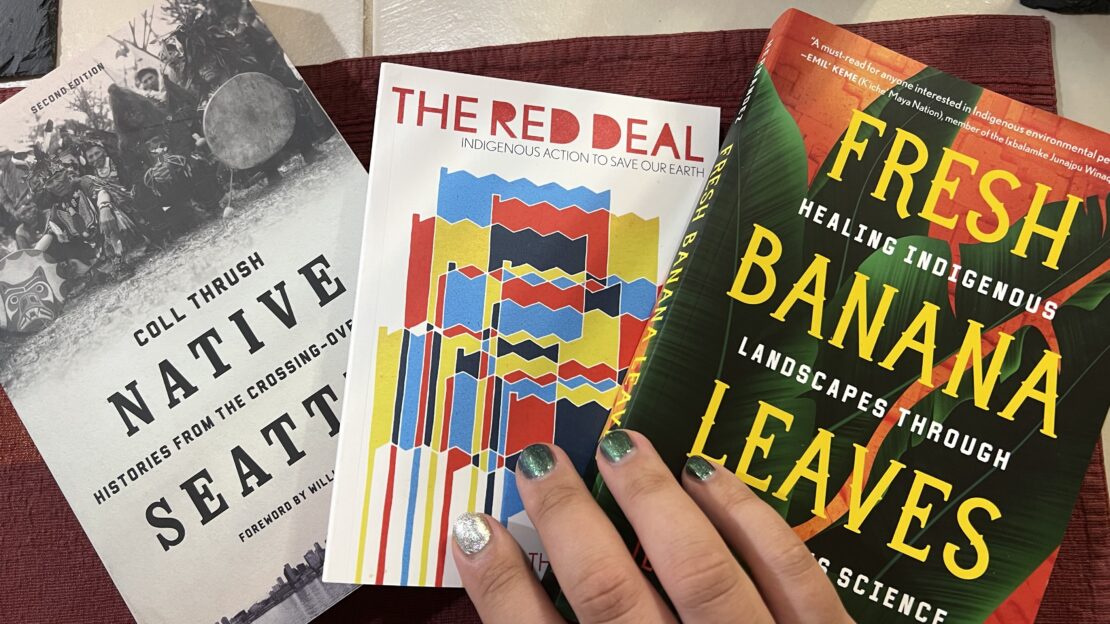
Update for 2023:
Monday, October 9 is Indigenous Peoples’ Day in the so-called United States. Here are some resources for you to check out and share!
We will continue to add to and update this page over time with more resources as we see fit, so you can bookmark this page and see what we add to it over time. The “Last Updated” message below will tell you when we last added resources to this page.
(Last updated: October 6, 2023)
Videos
Why Treaties Matter — A five-minute NPR video that introduces you to treaty rights and what they mean for Indigenous peoples in the United States.
Importance of Treaties with American Indian Tribes — Diving a little deeper, here’s a twelve-minute video on treaty rights with historian Dr. Nick Estes.
(For more on treaty rights, check out this brief primer from the Northwest Indian Fisheries Commission.)
Mishkos Kenomagwen: The Teachings of Grass — Plant ecologist Dr. Robin Wall Kimmerer makes a straightforward case as to why the environmental crisis cannot and will not be solved without Indigenous people (21-minute video).
Articles, Essays, Webpages
- Just Transition (Indigenous Environmental Network) — Front and Centered works to advance a Just Transition, but what does an Indigenous Just Transition look like? Check out this webpage by the Indigenous Environmental Network for one interpretation.
- Northern California Esselen Tribe Regains Ancestral Land After 250 Years — What could Land Back look like in practice? The Esselen Tribe in Central California recently purchased back their stolen land, regaining their ability to practice their culture in peace and privacy.
- Beyond Land Acknowledgment: A Guide — “Every moment spent agonizing over land acknowledgment wording is time that could be used to actually support Indigenous people.”
- The Day the Indians Took Over Seattle’s Fort Lawton—and Won Land Back — “It is this willingness to fight, to put it all on the line, including one’s own body if necessary, that protects Native people and cultures from extinction.”
Books
-
Estes, N. (2019). Our history is the future: Standing Rock versus the Dakota Access Pipeline, and the long tradition of Indigenous resistance. Brooklyn, NY: Verso Books.
-
Gilio-Whitaker, D. (2019). As long as grass grows: The Indigenous fight for environmental justice, from colonization to Standing Rock. Boston, MA: Beacon Press.
-
Harjo, J., Howe, L., Foerster, J. E., & Westerman, G. (2020). When the light of the world was subdued, our songs came through: A Norton anthology of Native Nations poetry. New York, NY: W. W. Norton & Company.
-
Hernandez, J. (2022). Fresh banana leaves: Healing Indigenous landscapes with Indigenous Science. Berkeley, CA: North Atlantic Books.
-
Kimmerer, R. W. (2013). Braiding Sweetgrass: Indigenous wisdom, scientific knowledge, and the teachings of plants. Minneapolis, MN: Milkweed Editions.
-
Moreton-Robinson, A. (2015). The white possessive: Property, power, and Indigenous sovereignty. Minneapolis, MN: University of Minnesota Press.
-
Red Nation, The (2021). The Red Deal: Indigenous action to save our Earth. Brooklyn, NY: Common Notions.
-
Simpson, L. B. (2017). As we have always done: Indigenous freedom through radical resistance. Minneapolis, MN: University of Minnesota Press.
-
Thirteen Books That Will Make You Rethink California’s Indigenous History (curated by the Peninsula Open Space Trust)
-
Thrush, Coll (2017). Native Seattle: Histories from the crossing-over place. Seattle, WA: University of Washington Press.


